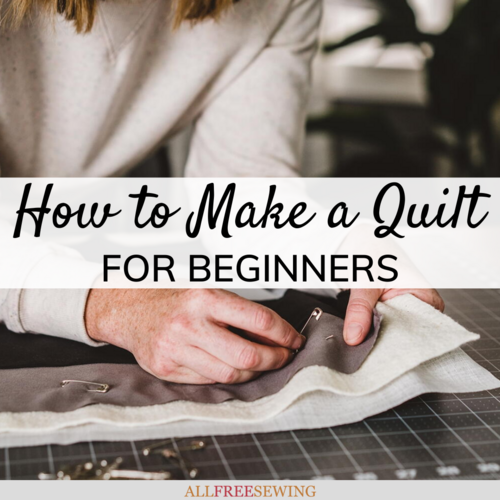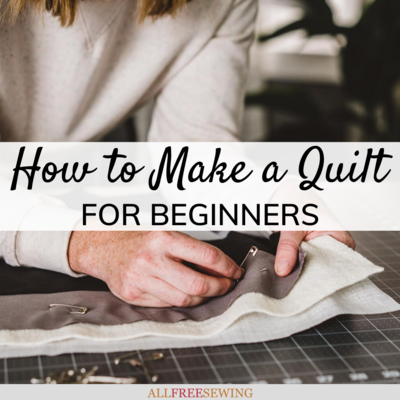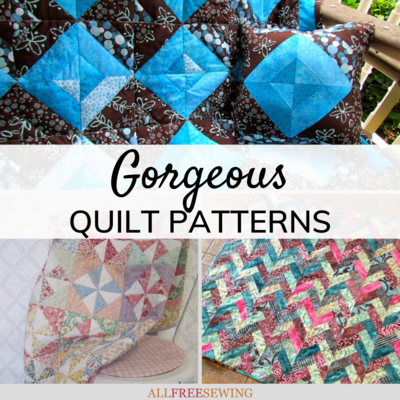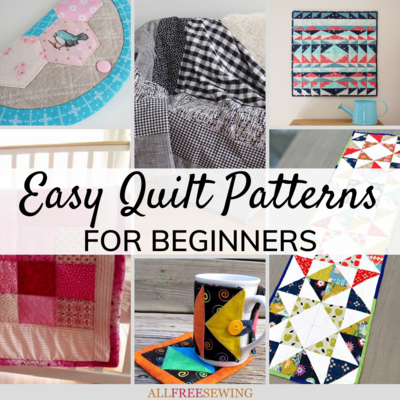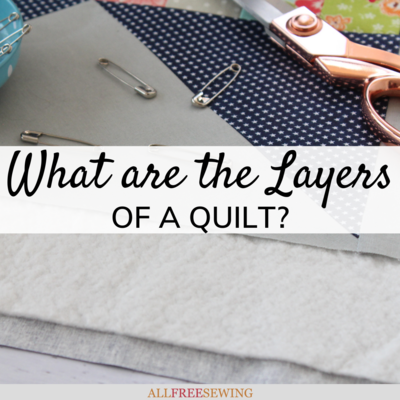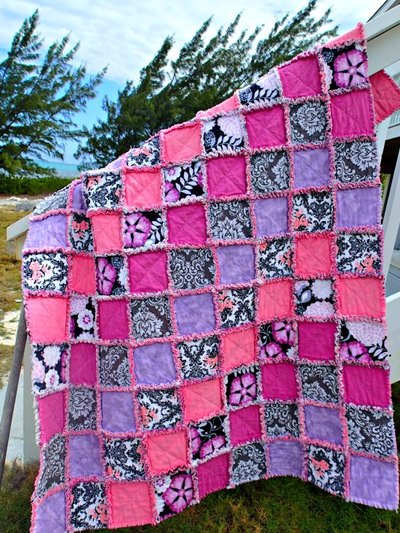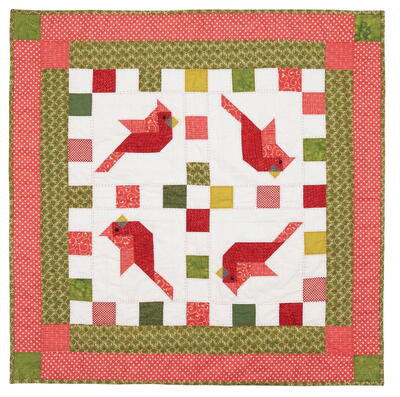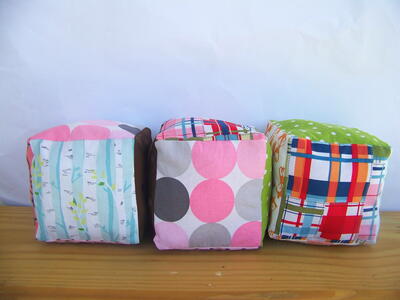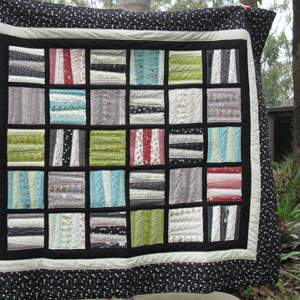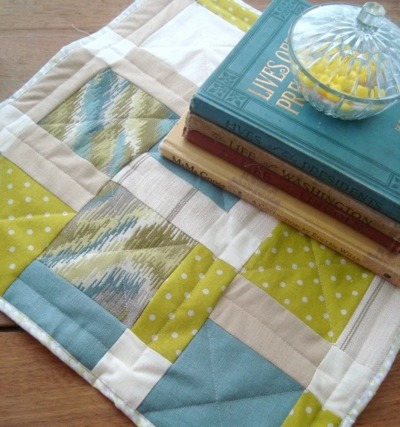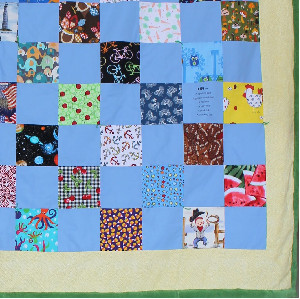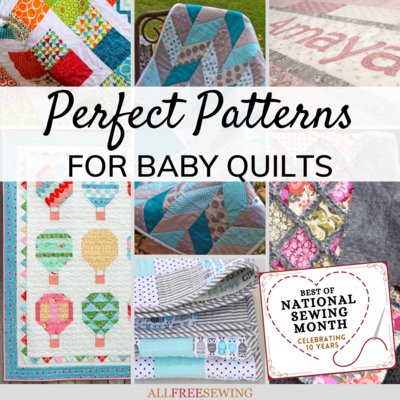How to Make a Quilt for Beginners
Learn how to make a quilt for beginners with pictures! This tutorial will show you how to easily make a quilt by hand and by machine.
If you have ever dreamed of making your own blankets, especially warm quilts to cozy up under, you’ve come to the right place. This tutorial, how to make a quilt for beginners, is the perfect place to start, even if you’ve never made a blanket before.
If it's your first time quilting or you're still getting started, then you might be confused about the process, what supplies you need, and the terms associated with quilting.
Our friends at FaveQuilts have a lot of beginner-friendly info and patterns, so be sure to visit them for even more help. This guide from Fiskars is a great one to start with, though.
Learn all about how to make a quilt with a sewing machine or by hand, read the pros and cons of each, and have your most pressing quilting questions answered below!
Although this handy tutorial is great for quilt beginners, this process will be a lot easier if you’re familiar with using a sewing machine or hand sewing.
But First! Beginner Quilter Resources
For additional help, take a look at these helpful resources and tutorials ideal for quilters. Everything below is going to help you learn how to quilt like a pro and more about quilting.
- Quilting Tips & Tricks from Our Readers
- Money Saving Tips for Quilting on a Budget
- What are the Layers of a Quilt?
- What To Do After Basting a Quilt?
- How Much Fabric Do I Need for a Quilt?
- How to Design a Quilt on Graph Paper
- How to Square Up a Quilt Block
- Preparing for Longarm Quilting
- Sew & Quilt Pressing Tips
- How to Make a Quilted Potholder
- How to Make a Quilted Pillow
- How to Make a T-Shirt Quilt
- How to Make a Quilted Long Pincushion
- How to Make a Quilted Wall Calendar
How to Make a Quilt for Beginners
Materials List:
For machine sewing
5 contrasting color fabrics (see measurements below)
Backing fabric
Binding fabric
Batting
Sewing machine
Fiskars® RazorEdge™ Table Top Shears
Iron
Straight pins
Batting
Ruler / Fiskars® Ruler Connector Set
Optional: Rotary cutter and heat erase marking pen
For hand sewing
Backing fabric
Binding fabric
Batting
Fiskars® Classic Stick Rotary Cutter, either 45mm or 60mm
Regular, good, sharp scissors, like Fiskars® Original Orange-handled Scissors™
Fiskars® Self-Healing 24" x 36" Cutting Mat (24" x 36" is best for large quilting projects)
Clear acrylic ruler
Straight pins
Safety pins
Seam ripper
Iron
How to Sew a Quilt (By Machine)
1. Cut the main fabric.
After gathering your supplies, place your main fabric on the Fiskars® Self-Healing 24" x 36" Cutting Mat and cut to 62" x 29" using the Fiskars® 45mm Classic Stick Rotary Cutter and the Fiskars® Ruler Connector Set to help you make longer cuts.
If you are not comfortable using a rotary cutter, you can use the
Fiskars® RazorEdge™ Table Top Shears that minimize fabric lift from the table, helping keep cuts straight.
2. Cut contrast fabric.
Cut five strips of contrast fabrics measuring the following:
1 piece 34" x 20"
1 piece 34" x 8"
1 piece 34" x 16"
1 piece 34" x 10"
1 piece 34" x 8"
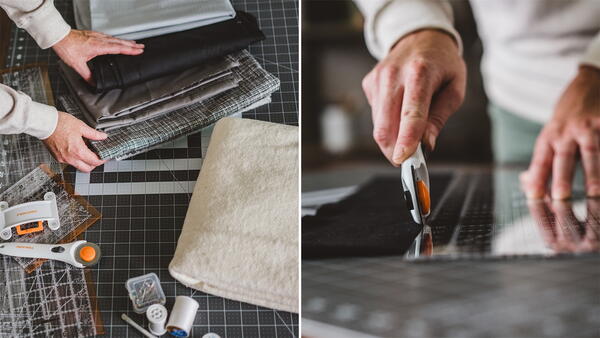
3. Sew the contrast fabric.
Using your sewing machine, sew the contrast fabric strips together with 1/4" seam allowance.
4. Iron your fabric.
Place the sewn fabric strips on the ironing board with the wrong side of the fabric facing you. Press each of the seams towards the darker fabric.
5. Pin and sew the main fabric.
Pin the contrast fabric strips to the main fabric and sew.
6. Trim the batting.
Use shears to cut thick batting at least 2" larger than the quilt top. Use shears that help keep materials flat on your surface for straight cuts like these, RazorEdge™ Fabric Shears for Tabletop Cutting (8").
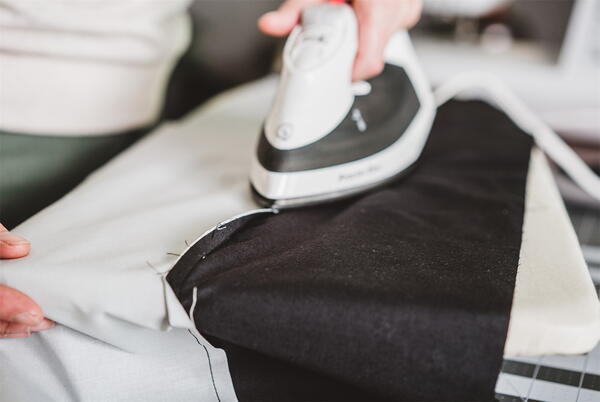
7. Sew the quilt backing.
Use the rotary cutter, rulers, and ruler connector to cut two lengths of backing fabric to 62" in length. Sew the two pieces together to give you a backing that is big enough for the entire quilt.
8. Cut the backing to size.
With the seam in the center, trim the backing fabric at least 2" larger than the quilt top using either your rotary cutter or scissors.
9. Assemble the quilt.
Pin the quilt top, batting, and backing fabric together, or use quilt adhesive to secure all layers.
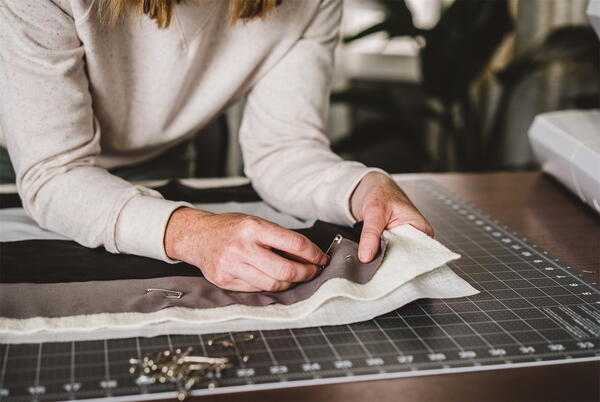
10. Quilt.
Quilt as desired. I measured and marked three lines 1" apart every 4" using a heat erase marking pen, as a guide for quilting. The pen lines are erased with the iron.
11. Cut binding strips.
Use the rotary cutter and acrylic ruler to cut seven 2-1/2" wide strips.
12. Sew the binding strips.
Sew the strips together. Check that they are long enough to go around the entire perimeter of the quilt. Place two strips together with the right sides facing each other. The strips should be perpendicular to each other. Sew across the diagonal. Trim the excess by 1/4".
13. Press the binding strips.
Using your iron, press the entire length of binding in half.
14. Sew the binding to the quilt.
Place the binding against the edge of the quilt. The raw edge of the binding should align with the raw edge of the quilt. Sew the binding to the right side of the quilt, a 1/4" away from the edge. Leave a 3" tail at the beginning.
15. Sew around the corners.
When you come to a corner, sew in a straight line until you are about 1/4" away from the end. Pivot the quilt so that you finish stitching at a 45-degree angle to your seam. Remove the quilt from the machine and fold over the binding. Begin sewing again from the top of the new edge.
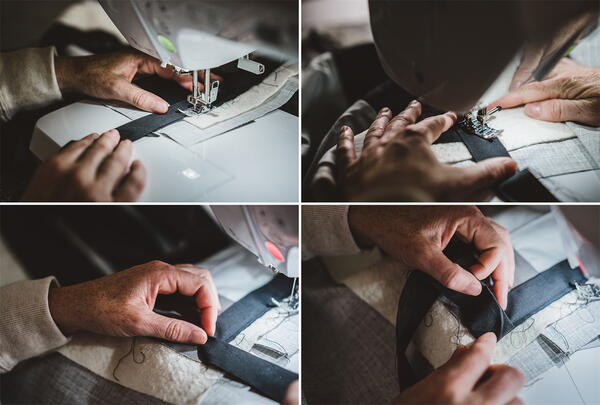
16. Join the binding ends.
Fold the end of one binding tail to create a neat, folded edge. Place the second tail inside the folded end. Join the ends by sewing them together
17. Finish the quilt.
Use the Fiskars® RazorEdge™ Easy Action™ Fabric Shears for Tabletop Cutting to again trim the batting to 1/2" and then switch to your Fiskars® Original Orange-handled Scissors™ or stick with your rotary cutter to trim the top to 1/2". Fold the binding and sew by hand to the wrong side of the quilt.
How to Make a Quilt (By Hand)
Learning how to make a simple quilt by hand is truly a lot easier than you may think. And once you have the basic quilting instructions down, it's just a matter of repeating the process. So if you're looking for quilting for beginners-type directions, this is for you!
1. Decide on your quilt pattern.
If this is your first quilt, go for a simple pattern for a small quilt. Limit your color pallet to a few colors or patterns, and use a basic block pattern. Full squares or triangles made from half squares are good options for first-time quilters. Do you have a baby shower coming up?
Baby quilts are smaller, so they're great for first projects. Keep in mind, you can also do a very basic "pattern" that doesn't require an actual pattern at all! With quilting, creativity is the name of the game!
2. Collect your materials and tools.
You don't need a lot of tools to quilt, but having everything you need on hand before you start is always a good idea. Be sure you read your pattern entirely so you know how much and what kind of fabric to purchase. You'll also need backing fabric, thread, binding fabric, and batting. If you don't have any sewing supplies, you should consider getting the tools listed below:
Rotary cutter, either 45mm or 60mm
Regular, good, sharp scissors, like the Original Orange-handled Scissors from Fiskars
Cutting mat, 24" x 36" is best for large quilting projects
Clear acrylic ruler
Straight pins
Safety pins
Seam ripper
Iron
To make it even easier, you can start with the Fiskars® Beginner Quilting Set which contains many of the above listed tools.
3. Prewash your fabric.
This is sort of an "optional" step - but it's one I live by. Prewashing your fabric does two things: rinses any extra dye out of the fabric and shrinks it. Both of these things can ruin your quilt when you wash it for the first time. Higher quality fabrics generally don't have this issue, but better to be safe than sorry.
4. Iron your fabric.
Before you cut your fabric, removing wrinkles will make the process much easier. Use your iron's steam setting if it has one.
5. Measure and cut your patchwork.
After deciding how big you want your quilt to be, you can work backward, determining the size of each square - remember to factor in a seam allowance. A good rule of thumb is to add 1/4" per side. So, if you are making a quilt with 3" x 3" squares, you actually want to cut each square to 3-1/2" x 3-1/2".
If you're using a pattern, the dimensions will be detailed for you. Once you've measured, you can cut each piece out to the determined size. You must be very accurate with your cuts. Use your clear acrylic ruler and your rotary cutter to cut each piece. Be sure you place the fabric on your cutting mat so you don't roll into the table or work surface underneath.
6. Lay your quilt out.
This is my favorite part! Lay your quilt out according to the finished design you want. Move pieces around, swap prints in different places. Let your creativity take over. This step is best done on the floor, where you can spread out. Once you're satisfied with the design, pick up your patches in rows, being careful to keep them in order. Working left to right, simply pick up and place each piece on top of the last from the previous row.
7. Sew your patchwork into rows.
You want to take care to sew a perfectly straight seam so you don't end up with a puckered finish product or with unmatched seams as you work your way down the quilt. Sew several individual rows together. Remember - be careful to use a straight stitch and to be precise in your 1/4" seam.
8. Iron your rows.
After you have all your long rows sewn together, you need to press the seams so they'll lay flat. Flip your quilt upside down, so the unfinished side is up. Iron each seam flat, alternating directions. In the first row, iron the underside of the seam flat to the right side, the second row, iron flat to the left side, and so on.
9. Sew the quilt all together.
Once your rows are all together, it's time to sew each row to the next, again taking care to use a consistent, exact 1/4" seam. Take row 1 and row 2, turn them both inward so the finished sides are facing one another. Sew, using a straight stitch just like you did when making the rows. Repeat until all your rows are aligned and sewn together.
10. Iron your whole quilt.
This time, you'll iron the front side of your quilt. Use the same technique and process you did with the rows, alternating the direction you iron the underside seams flat.
11. Make your quilt sandwich and baste your quilt.
You're now at the basting step. Basting will temporarily hold your quilt "sandwich" together - a quilt sandwich refers to all the layers of your quilt...the front, the batting (or stuffing), and the backing.
Layer your quilt in the correct order:
- Backing - right side down. You want to cut your backing at least 5" wider on all sides than the actual size of your quilt.
- Batting - the stuffing, or middle of the quilt. Make your batting a few inches wider than your top layer.
- Front - right side up.
Notes:
• If you use spray, you want to spray each layer before adding the next when you're making your sandwich.
• If you pin, you'd simply use safety pins starting in the center and moving out in all directions. You could also opt to use both techniques (spraying and then pinning) if you want to be extra careful.
12. Stitching.
Decide how you want to stitch your quilt together before you start. You can be super fancy, or you can stick to a simple, straight-lined, rowed pattern.
13. Time to bind!
Binding gives a quilt that finished look you want, with a soft border all the way around the patchwork. There are several ways to bind your quilt, and ultimately the method you choose will just come down to personal preference.
But my favorite way to bind is this:
• First, I square off the quilt. You do this by sewing all along the perimeter of all four sides of your quilt. I usually make the seam about 1/8" in. I then trim the edge all the way around.
• To make your binding, cut strips of the fabric you'll use to bind your quilt. The width of the fabric you cut depends on how wide you want the bind to be. I usually do about a 2-1/2" width, but yours will depend on how large your quilt is.
• Cut the length long enough to run the entire length of each side. You want four strips, one for each side of your quilt.
• Pin your binding in place. Use a lot of safety pins for this step - you want the binding very secure so you don't have any puckers or uneven edges once you sew.
• Lay your binding face-to-face (pattern sides together) and sew from the backside with about a 1/2" seam. Go all the way around, folding the binding out at the end. You'll have a finished seam and a pretty edge.
• Finish the corners by sewing a diagonal stitch from corner to corner.
• Trim the outer triangle at the seam.
• Repeat these steps until all the sides are sewn together, and then unfold to create one long continuous binding strip.
• Fold the strip in half, ironing it to crease along the center.
• Using straight pins, pin your binding all around the top side of the quilt with the rough side out, and the folded side toward the middle of your quilt. Be sure to leave a tail (about 8") hanging off your quilt, unpinned.
• As you get near each corner, fold the ends together into an upward triangle. Insert a pin through and on either side of the upwards triangle. Once you've gone all the way around your quilt, you will "join" the strips. Fold the left side strip down and trim as you see here.
• Lay the right side binding strip inside the folded strip as shown. Pin to secure.
• Stitch around the edge of your binding - you want your seam about 1/4" from the rough edge.
• Fold the binding over to the backside of your quilt, pin in place, and use a small, sharp needle to hand-stitch the binding to the back.
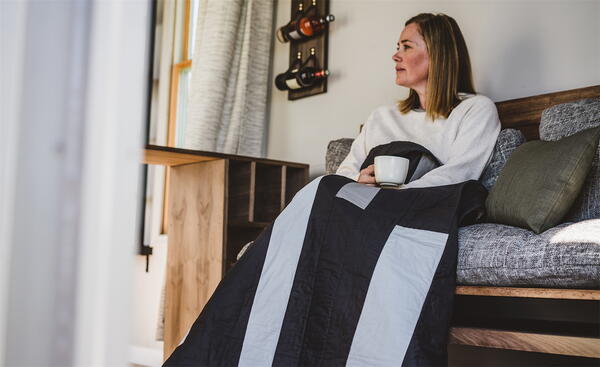
Pros and Cons: Machine Quilting vs Hand Quilting
There's no right or wrong answer in terms of "which is better" when it comes to hand quilting vs. machine quilting. For quilt making, the way you go about it really just comes down to a matter of choice.
Machine Quilting Overview
Benefits of Machine Quilting:
• It is faster.
• It is easier.
• Can do straight lines or diagonal lines on a grid.
Drawbacks of Machine Quilting:
• May not be perceived as "as special" (most likely only in your own eyes).
• Some quilters experience neck and back pain from the repetitive, short pushing and pulling motion of sewing such a big project on a machine.
• Can be expensive to purchase if you don't already have a machine.
Hand Quilting Overview
Benefits of Quilting by Hand:
• Heirloom quality.
• Sentimentality.
• Fun, for those who love the craft of quilting.
Drawbacks of Quilting by Hand:
• Learning how to sew a quilt completely by hand may take a lot longer.
• If you're not an accomplished seamstress, your stitches and seams may be uneven.
• May not be as durable.
Types of Quilts
• Pieced: More commonly known as patchwork quilts, the pieced is one of the most common of quilt styles - it's made up of patches of material pieced together.
• Applique Quilts: Applique is a technique where you sew shapes onto a background to create a beautiful design.
• Paper Piecing: This technique is quite popular these days. It's created by stitching your fabric design onto a patterned, oftentimes numbered paper foundation. Think of it like paint by numbers...only quilting.
• English Paper Piecing: Similar to regular paper piecing, English paper piecing is a traditional quilting style that uses shapes with many sides, like hexagons.
Similar shapes are cut out of paper, and the fabric is folded and basted around them. Each individual shape is then whip-stitched together by hand.
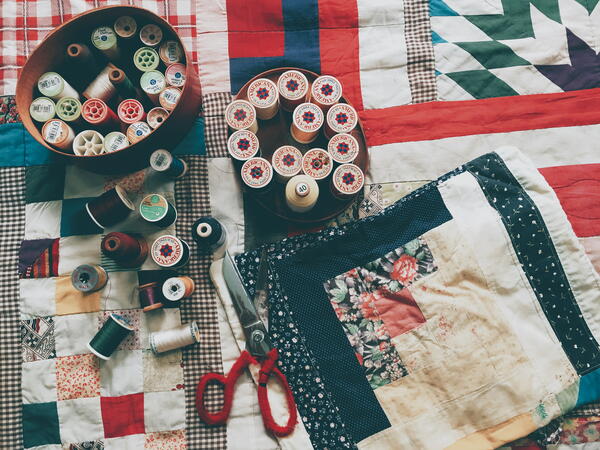
Best Fabrics for Quilting
• Home Decor Weight Cotton: This heavy cotton is great for home quilters. It has a pretty sateen finish and doesn't drape due to its heavier weight. Keep in mind that because it's so heavy, you can use a light batting with this quilting material.
• Quilter's Weight Cotton: Widely considered one of the, if not the, best cotton fabrics to quilt with. Its high quality and it will shrink less than cheaper cotton versions.
• Essex Linen: This natural linen-cotton blend is by Robert Kaufmann and is loved by quilters all over, especially when combined with weighted styles of fabric.
• Voile: A bit transparent, voile is a lightweight cotton that can almost be described as silky. It's a popular option for backing your quilt.
• Quilter's Linen: Another fabric by Robert Kaufmann, quilter's linen is actually made from cotton but has the look and feel of linen.
Common Quilting Questions and Answers + Resources
What is a Quilting Stitch?
Most quilters use a simple running stitch when quilting by hand. Insert the needle through the front of the fabric, catch a little bit of the back and then reinsert through all the layers.
How Do You Make a Quilt Sandwich?
You make a quilt sandwich by placing all the layers together, including: the backing, the batting, and the top of your quilt. Keep in mind that the bottom layer should be right side down, and the top should be right side up.
What is Batting for Quilts?
Batting is the cottony, thick material that goes in the center of your quilt. It’s what gives the quilt a “poofiness” once you stitch your pattern.
What is a Quilter's Knot?
A quilter's knot is a very small knot that can go through one layer of fabric so you can hide the tail in between the fabric.
How Long Should a Quilting Stitch Be?
How long your quilting stitch should really depend on if you're machine sewing or sewing your quilt by hand. If you're using a machine, set your stitch length to about 2-1/2"–3". If you're stitching by hand, you want about 8–12 stitches per inch.
What Are Quilting Blocks?
Quilting blocks are any units you sew together. To create your quilt, you assemble all your quilt blocks together to form a pattern or design.
Quilting vs Sewing: What's the Difference?
Quilting is actually a type of sewing. It's the process of stitching together two or more layers of fabric.
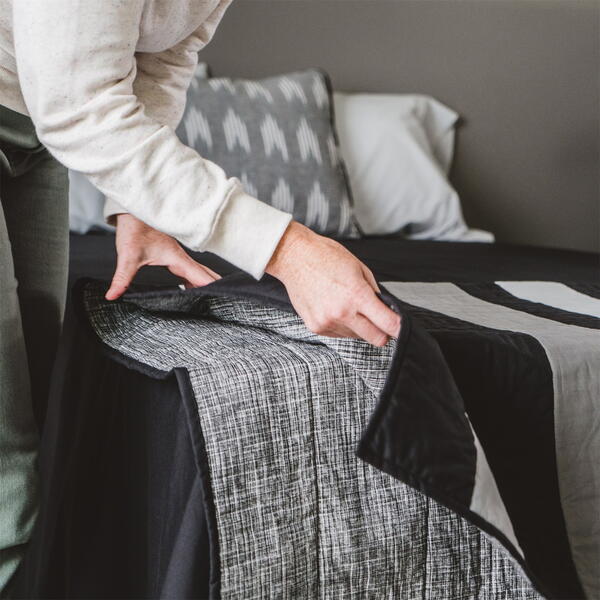
Want More?
How to Make a Soft Baby Blanket >>>
What else do you want to learn about quilting?
Or, do you have any tips for beginners?
Let us know in the comments!
Read NextHappy and Scrappy Blocks Quilt
Your Recently Viewed Projects
ridiculosity 67303 43
Sep 15, 2021
In 'How to sew a quilt", #3, sew which direction? #5, again which direction or side? #12,which way, how much? #15, Huh? That "explanation" was not informative to me and I've done miles of sewing. How is this for the beginner? Where are the pictures? At least there should be one picture of what your description will make, the way you are directing. So confusing.
Report Inappropriate Comment
Are you sure you would like to report this comment? It will be flagged for our moderators to take action.
Thank you for taking the time to improve the content on our site.

